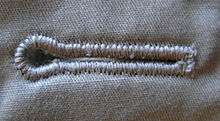Buttonhole

Buttonholes are holes in fabric which allow buttons to pass through, securing one piece of the fabric to another. The raw edges of a buttonhole are usually finished with stitching. This may be done either by hand or by a sewing machine. Some forms of button, such as a frog, use a loop of cloth or rope instead of a buttonhole. Buttonholes can also refer to flowers worn in the lapel buttonhole of a coat or jacket, which are referred to simply as "buttonholes" or boutonnières.
History
Buttonholes for fastening or closing clothing with buttons appeared first in Germany in the 13th century. However it is believed that ancient Persians used it first.[1] They soon became widespread with the rise of snug-fitting garments in 13th- and 14th-century Europe.
Aspects of buttonholes
Buttonholes often have a bar of stitches at either side of them. This is a row of perpendicular hand or machine stitching to reinforce the raw edges of the fabric, and to prevent it from fraying.
Traditionally, men's clothing buttonholes are on the left side, and women's clothing buttonholes are on the right. The lore of this 'opposite' sides buttoning is that the practice came into being as 'women of means' had chamber maids who dressed them. So as not to confuse the poor chamber maids, the wealthy began having women's garments made with the buttons and holes 'switched'; the birth of the modern ladies' blouse. The chamber maids themselves, as did most all the common class, both male and female, actually wore 'shirts' with buttons and holes placed as on men's clothing. There appears to be no concrete reference to prove or disprove this story, but its plausibility bears noting.
There is also the theory that if a man is driving his ox cart or carriage or car, he can see inside her blouse and she can see inside of his. (Of course this assumes the driver is on the left hand side.)
Types of buttonholes
Hand stitching
- A plain buttonhole, by far the most common type. In plain buttonholes, the raw (cut) edges of the textile are finished with thread in very closely spaced stitches (if made by hand, often the buttonhole stitch) with a gimp cord at the edges to act as a reinforcement. When stitched by hand, a slit is made in the fabric first and the result is called a worked buttonhole.
Machined stitching
Sewing machines offer various levels of automation to creating plain buttonholes. When made by machine, the slit between the sides of the buttonhole is opened after the stitching is completed.
- A machine-made buttonhole is usually sewn with two parallel rows of machine sewing in a narrow zig-zag stitch, with the ends finished in a broader zig-zag stitch. (One of the first automatic buttonhole machines was invented by Henry Alonzo House in 1862.)
- A bound buttonhole is one which has its raw edges encased by pieces of fabric or trim instead of stitches.
- A keyhole buttonhole is a special case of a thread-finished buttonhole that is normally machine-made due to the difficulty of achieving it by hand working. It is characterized by a round hole at the end of the slit. Because a button-closed gap in a garment is normally under some stress, the button will tend to move towards the end of the buttonhole closest to the gap in the garment. A keyhole at the end of the buttonhole closest to the gap will accommodate the button's shank without distorting the fabric.
Keyhole buttonholes are most often found on tailored coats and jackets.
See also
References
| Wikimedia Commons has media related to Buttonholes. |
- ↑ Lynn White: "The Act of Invention: Causes, Contexts, Continuities and Consequences", Technology and Culture, Vol. 3, No. 4 (Autumn, 1962), pp. 486-500 (497f. & 500)